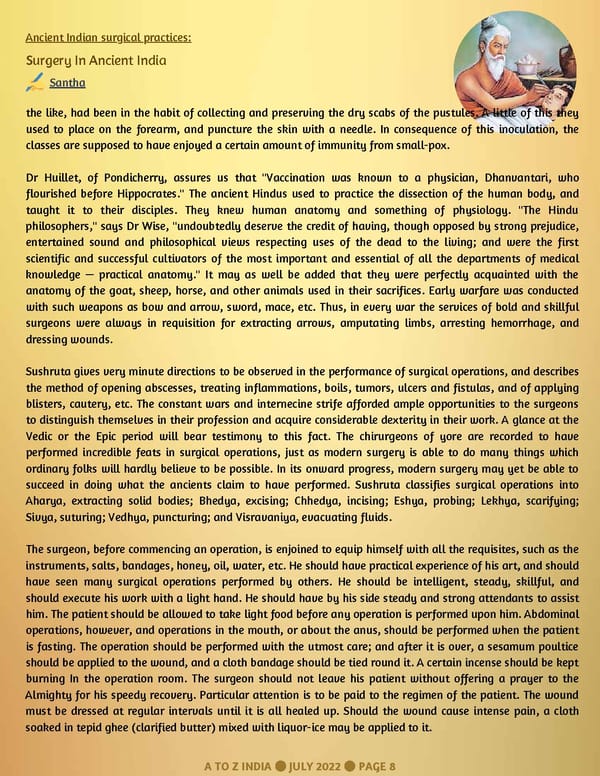the like, had been in the habit of collecting and preserving the dry scabs of the pustules. A little of this they used to place on the forearm, and puncture the skin with a needle. In consequence of this inoculation, the classes are supposed to have enjoyed a certain amount of immunity from small-pox. Dr Huillet, of Pondicherry, assures us that "Vaccination was known to a physician, Dhanvantari, who fl ourished before Hippocrates." The ancient Hindus used to practice the dissection of the human body, and taught it to their disciples. They knew human anatomy and something of physiology. "The Hindu philosophers," says Dr Wise, "undoubtedly deserve the credit of having, though opposed by strong prejudice, entertained sound and philosophical views respecting uses of the dead to the living; and were the first scientific and successful cultivators of the most important and essential of all the departments of medical knowledge — practical anatomy." It may as well be added that they were perfectly acquainted with the anatomy of the goat, sheep, horse, and other animals used in their sacrifices. Early warfare was conducted with such weapons as bow and arrow, sword, mace, etc. Thus, in every war the servi ces of bold and skillful surgeons were always in requisition for extracting arrows, amputating limbs, arresting hemorrhage, and dressing wounds. Sushruta gives very minute directions to be observed in the performance of surgical operations, and describes the method of opening abscesses, treating inflammations, boils, tumors, ulcers and fistulas, and of applying blisters, cautery, etc. The constant wars and internecine strife afforded ample opportunities to the surgeons to distinguish themselves in their profession and acquire considerable dexterity in their work. A glance at the Vedic or the Epic period will bear testimony to this fact. The chirurgeons of yore are recorded to have performed incredible feats in surgical operations, just as modern surgery is able to do many things which ordinary folks will hardly believe to be possible. In its onward progress, modern surgery may yet be able to succeed in doing what the ancients claim to have performed. Sushruta classifies surgical operations into Aharya, extracting solid bodies; Bhedya, excising; Chhedya, incising; Eshya, probing; Lekhya, scarifying; Sivya, suturing; Vedhya, puncturing; and Visravaniya, evacuating fluids. The surgeon, before comme ncing an operation, is enjoined to equip himself with all the requisites, such as the instruments, salts, bandages, honey, oil, water, etc. He should have practical experience of his art, and should have seen many surgical operations performed by others. He should be intelligent, steady, skillful, and should execute his work with a light hand. He should have by his side steady and strong attendants t o assist him. The patient should be allowed to take light food before any operation is performed upon him. Abdominal operations, however, and operations in the mouth, or about the anus, should be performed when the patient is fasting. The operation should be performed with the utmost care; and after it is over, a sesamum poultice should be applied to the wound, and a cloth bandage should be tied round it. A certain incense should be kept burning In the operation room. The surgeon should not leave his patient without offering a prayer to the Almighty for his speedy recovery. Particular attention is to be paid to the regimen of the patient. The wound must be dressed at regular intervals until it is all healed up. Should the wound cause intense pain, a cloth soaked in tepid ghee (clarified butter) mi xed with liquor-ice may be applied to it. A TO Z INDIA JULY 2022 PAGE 8 Santha Surgery In Ancient India Ancient Indian surgical practices:
 A TO Z INDIA - JULY 2022 Page 7 Page 9
A TO Z INDIA - JULY 2022 Page 7 Page 9